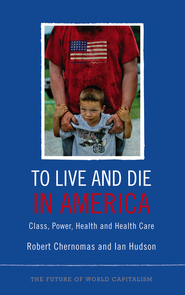U.S.
To Live and Die in America: Profit is not the Cure
August 23, 2013 · 0 Comments

By Robert Chernomas and Ian Hudson:
This summer the Times is running a series on health care in the U.S. called “Paying Till it Hurts.” The Times should perhaps be credited with getting some things correct, but as any patient knows, in the world of health being partly right can be very wrong.
| The authors present The Gatekeeper. Read an excerpt. |
In our book The Gatekeeper about the economic ideology of the Times over the past 60 years, we found that its reporting on domestic economic issues like regulation reflected that of a forward looking member of the business community. What we meant by this was that the Times’ reporting favors the long term interests of business in general. This does not mean it was uncritical of all business activities. In fact, it was heavily critical of actions taken by businesses that were self-destructive or those that helped one subsection of business at the expense of the broader corporate community. This was certainly the stance taken by the Times on both the financial crisis and the energy scandals of Enron. However, there were important limits to the Times’ criticisms of corporate America. Its reporting only rarely systematically linked major economic problems to the U.S. business class as a whole preferring instead to rely on the “bad apple” explanation of individual wrong doing by fingering poorly behaving firms (or even industries).
The first story in the “Paying Till it Hurts” series, on colonoscopies (The $2.7 Trillion Medical Bill: Colonoscopies Explain Why U.S. Leads the World in Health Expenditures June 1, 2013) follows this trend. It correctly points out that pretty much any health care procedure, including colonoscopies, in the U.S. is much more expensive than elsewhere in the world, yet the results are no better. The story also points out the superficial reasons for this. First, colonoscopies in the U.S. are performed more often than they need to be, and certainly far more often than in most other countries, where other just as effective but cheaper procedures are often used. Second, each colonoscopy in the U.S. costs considerably more than elsewhere. The average U.S. price of $1200 is just under twice that of Switzerland. Much of this cost difference is made up of unnecessary add ons, like performing the procedure in a special surgery center rather than in the more mundane, but perfectly acceptable, confines of a doctor’s office. While these facts are bang on, they beg the question about why these cost escalators happen in the U.S. more than other countries.
The Times does get the answer to this question partly correct. It points out that part of the problem is medical businesses maximizing revenue in a context where governments do not interfere with pricing and patients feel that, “if a doctor says you need it, you don’t ask.”
Yet the diagnosis also contains some important flaws and omissions. Perhaps the most glaring flaw is the Times’ insistence that having patients bear more the cost would help keep health costs down:
Consumers, the patients, do not see prices until after a service is provided, if they see them at all. And there is little quality data on hospitals and doctors to help determine good value, aside from surveys conducted by popular Web sites and magazines. Patients with insurance pay a tiny fraction of the bill, providing scant disincentive for spending.
While it is true that making patients pay will reduce the amount that they will access health care, precisely because they don’t really have the knowledge to determine which procedures they need and which are more optional, they often don’t make the correct decisions about what to cut back on. This fact has been long established ever since a ground breaking Rand study in the 1970s that randomly assigned patients to groups that had to pay different amount of out of pocket expenses for their medical care. The study found that while families with higher payments did access fewer medical treatments, they used less of all kinds of services, even those that would have been extremely valuable.
The U.S. healthcare system relies more on private, for- profit delivery of both insurance and services than other developed countries. It has historically not guaranteed access to millions of its citizens who are uninsured, and even under Obama’s Affordable Care Act (ACA), people will still be deterred from seeking medical care because of the payments associated with private insurance. It is also very expensive. Similar health results have been achieved with much lower costs in systems that rely less on for profit delivery. To take an obvious example, the Canadian healthcare system, although far from perfect, is measurably superior to that currently in place in the United States, even with the passage of the ACA. It is more equal, has universal access and delivers similar results at a fraction of the cost.
In our most recent book, To Live and Die in America, we argue that the unique health care system in the U.S. is not a result of the will of the people, in any meaningful sense. Rather, it is the result of a political battle between a relatively weak and disorganized citizenry, without any meaningful political representation, against a very well-funded and organized section of the corporate world, with an enormous stake in the continuation and expansion of a profit making health care industry: the Medical Industrial Complex (MIC). According to one academic, “What has become clear is that the unique problems the U.S. medical-industrial complex has created are rooted in the subordination of the state and civil society to corporate interests.”(i)
A particularly revealing exposé of the tactics employed by the MIC can be found in Wendell Potter’s book Deadly Spin. As the former chief of public relations for health insurance company Cigna, Potter has an insider’s view of the industry’s efforts to influence the debate around public insurance. To take just one example, when Clinton was proposing healthcare reform in 1994 the insurance industry funded a $14 million advertising campaign in which ‘Harry and Louise’, two burdened everyday suburbanites, lamented the state of a hypothetical future government health program run by bureaucrats with the tagline “when they choose we lose.”
Forcing patients to pay more of their health costs is to blame the victim. The bloated and inequitable U.S. system serves those who profit from it. By and large the rest of the industrialized world produce more effective, efficient and accessible health care systems by either eliminating the for-profit private sector altogether from health care delivery or through heavy regulation. “The $2.7 Trillion Medical Bill” fails to prescribe the obvious cure. If the problem is a for profit system held in place by the political machinations of powerful industry, then surely the solution is to do away with the for profit system in both insurance and service delivery.
Robert Chernomas is Professor of Economics at the University of Manitoba, Canada. He has been a visiting professor at the Johns Hopkins School of Public Health and is on the editorial board of International Journal of Health Services.
Ian Hudson is Associate Professor of Economics at the University of Manitoba, Canada.
Notes:
(i) Estes, C., Harrington, C., and Pellow, D. (2000) “‘Medical-industrial complex”’, in E. Borgatta, E., and R. Montgomery, R. (eds), Enclyclopedia of Sociology, (Farmington Hills, MI: The Gale Group).
By admin











Sorry, comments are closed on this post.